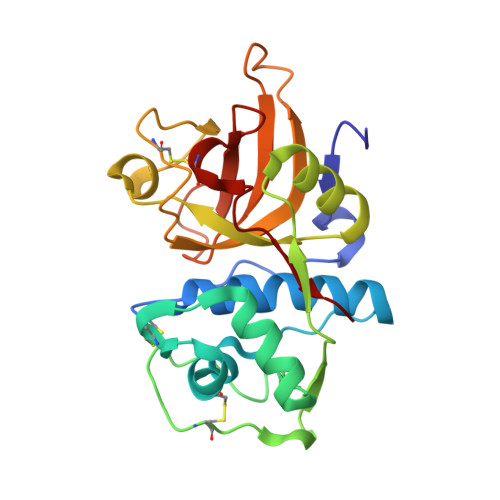Structural basis for reversible and irreversible inhibition of human cathepsin L by their respective dipeptidyl glyoxal and diazomethylketone inhibitors.
Shenoy, R.T., Sivaraman, J.(2011) J Struct Biol 173: 14-19
- PubMed: 20850545
- DOI: https://doi.org/10.1016/j.jsb.2010.09.007
- Primary Citation of Related Structures:
3OF8, 3OF9 - PubMed Abstract:
Cathepsin L plays a key role in many pathophysiological conditions including rheumatoid arthritis, tumor invasion and metastasis, bone resorption and remodeling. Here we report the crystal structures of two analogous dipeptidyl inhibitor complexes which inhibit human cathepsin L in reversible and irreversible modes, respectively. To-date, there are no crystal structure reports of complexes of proteases with their glyoxal inhibitors or complexes of cathepsin L and their diazomethylketone inhibitors. These two inhibitors - inhibitor 1, an α-keto-β-aldehyde and inhibitor 2, a diazomethylketone, have different groups in the S1 subsite. Inhibitor 1 [Z-Phe-Tyr (OBut)-COCHO], with a K(i) of 0.6nM, is the most potent, reversible, synthetic peptidyl inhibitor of cathepsin L reported to-date. The structure of the inhibitor 1 complex was refined up to 2.2Å resolution. The structure of the complex of the inhibitor 2 [Z-Phe-Tyr (t-Bu)-diazomethylketone], an irreversible inhibitor that can inactivate cathepsin L at μM concentrations, was refined up to 1.76Å resolution. These two inhibitors have substrate-like interactions with the active site cysteine (Cys25). Inhibitor 1 forms a tetrahedral hemithioacetal adduct, whereas the inhibitor 2 forms a thioester with Cys25. The inhibitor 1 β-aldehyde group is shown to make a hydrogen bond with catalytic His163, whereas the ketone carbonyl oxygen of the inhibitor 2 interacts with the oxyanion hole. tert-Butyl groups of both inhibitors are found to make several non-polar contacts with S' subsite residues of cathepsin L. These studies, combined with other complex structures of cathepsin L, reveal the structural basis for their potency and selectivity.
- Department of Biological Sciences, National University of Singapore, Singapore 117543, Singapore.
Organizational Affiliation:

















